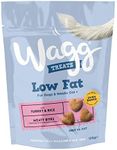Buying Guide for the Best Low Fat Dog Foods
Choosing the right low-fat dog food is important for your pet’s health, especially if your dog has specific dietary needs such as weight management, pancreatitis, or other health concerns. The goal is to find a food that provides balanced nutrition while keeping fat content low. When shopping, focus on the ingredient list, nutritional information, and your dog’s unique needs like age, activity level, and any medical conditions. Always consult your veterinarian before making significant changes to your dog’s diet.Fat ContentFat content refers to the percentage of fat in the dog food, usually listed as 'crude fat' on the packaging. This is important because dogs with certain health issues or those needing to lose weight benefit from lower fat intake. Fat content in dog food can range from very low (under 8%) to moderate (8-15%) and high (over 15%). For low-fat dog foods, look for options with fat content under 10%. If your dog has a medical condition like pancreatitis, your vet may recommend even lower fat levels. For healthy dogs needing to lose a little weight, a moderate reduction may be enough. Always match the fat content to your dog’s health requirements and activity level.
Protein Source and ContentProtein is a key nutrient for dogs, helping to maintain muscle and overall health. In low-fat dog foods, the protein source is often lean meats like chicken, turkey, or fish. Protein content can vary, but it’s important that the food still provides enough protein to keep your dog healthy. Look for foods with a protein content that matches your dog’s needs: active dogs or those recovering from illness may need higher protein, while less active or older dogs may do well with moderate levels. Always check that the protein comes from quality animal sources rather than fillers.
Fiber ContentFiber helps with digestion and can make your dog feel fuller, which is useful in weight management. Low-fat dog foods often have added fiber from ingredients like beet pulp, pumpkin, or brown rice. Fiber content can range from low (under 3%) to high (over 6%). If your dog needs to lose weight or has digestive issues, a higher fiber content can help. However, too much fiber can cause digestive upset, so it’s important to find a balance that suits your dog’s tolerance and needs.
Calorie DensityCalorie density refers to how many calories are in a given amount of food. This is important because even low-fat foods can be high in calories, which may not help with weight loss or management. Calorie density is usually listed as kcal per cup or per kilogram. For dogs needing to lose weight or maintain a healthy weight, choose foods with lower calorie density so you can feed a satisfying portion without overfeeding. For very active dogs, a slightly higher calorie density may be appropriate.
Ingredient QualityThe quality of ingredients in your dog’s food affects their overall health and well-being. Look for foods with whole, recognizable ingredients and avoid those with excessive fillers, artificial colors, or preservatives. High-quality ingredients are easier to digest and provide better nutrition. If your dog has allergies or sensitivities, pay close attention to the ingredient list and avoid known triggers. Always choose a food that matches your dog’s specific dietary needs and preferences.








